2014 NISSAN GT-R lock
[x] Cancel search: lockPage 13 of 354
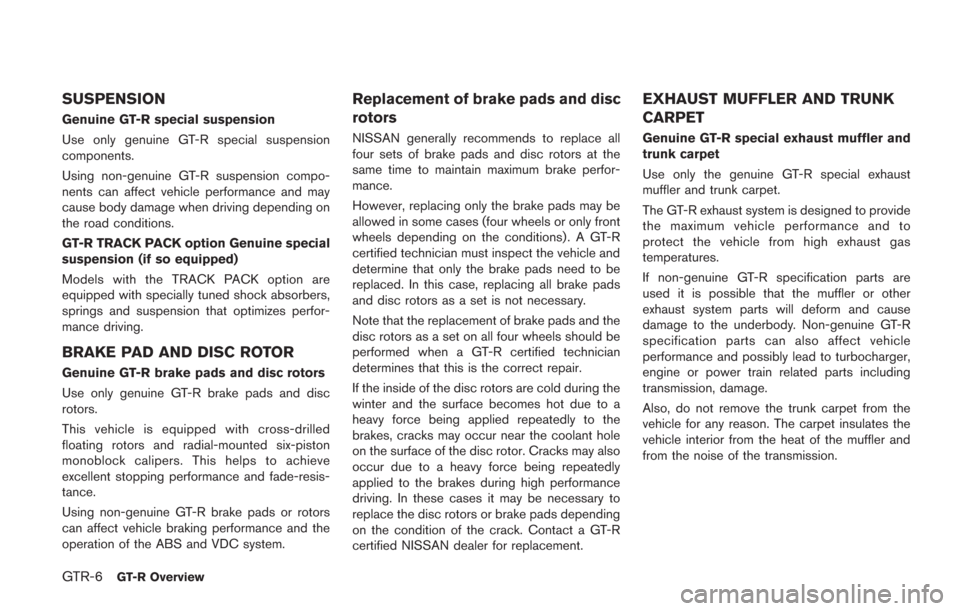
GTR-6GT-R Overview
SUSPENSION
Genuine GT-R special suspension
Use only genuine GT-R special suspension
components.
Using non-genuine GT-R suspension compo-
nents can affect vehicle performance and may
cause body damage when driving depending on
the road conditions.
GT-R TRACK PACK option Genuine special
suspension (if so equipped)
Models with the TRACK PACK option are
equipped with specially tuned shock absorbers,
springs and suspension that optimizes perfor-
mance driving.
BRAKE PAD AND DISC ROTOR
Genuine GT-R brake pads and disc rotors
Use only genuine GT-R brake pads and disc
rotors.
This vehicle is equipped with cross-drilled
floating rotors and radial-mounted six-piston
monoblock calipers. This helps to achieve
excellent stopping performance and fade-resis-
tance.
Using non-genuine GT-R brake pads or rotors
can affect vehicle braking performance and the
operation of the ABS and VDC system.
Replacement of brake pads and disc
rotors
NISSAN generally recommends to replace all
four sets of brake pads and disc rotors at the
same time to maintain maximum brake perfor-
mance.
However, replacing only the brake pads may be
allowed in some cases (four wheels or only front
wheels depending on the conditions). A GT-R
certified technician must inspect the vehicle and
determine that only the brake pads need to be
replaced. In this case, replacing all brake pads
and disc rotors as a set is not necessary.
Note that the replacement of brake pads and the
disc rotors as a set on all four wheels should be
performed when a GT-R certified technician
determines that this is the correct repair.
If the inside of the disc rotors are cold during the
winter and the surface becomes hot due to a
heavy force being applied repeatedly to the
brakes, cracks may occur near the coolant hole
on the surface of the disc rotor. Cracks may also
occur due to a heavy force being repeatedly
applied to the brakes during high performance
driving. In these cases it may be necessary to
replace the disc rotors or brake pads depending
on the condition of the crack. Contact a GT-R
certified NISSAN dealer for replacement.
EXHAUST MUFFLER AND TRUNK
CARPET
Genuine GT-R special exhaust muffler and
trunk carpet
Use only the genuine GT-R special exhaust
muffler and trunk carpet.
The GT-R exhaust system is designed to provide
the maximum vehicle performance and to
protect the vehicle from high exhaust gas
temperatures.
If non-genuine GT-R specification parts are
used it is possible that the muffler or other
exhaust system parts will deform and cause
damage to the underbody. Non-genuine GT-R
specification parts can also affect vehicle
performance and possibly lead to turbocharger,
engine or power train related parts including
transmission, damage.
Also, do not remove the trunk carpet from the
vehicle for any reason. The carpet insulates the
vehicle interior from the heat of the muffler and
from the noise of the transmission.
Page 18 of 354
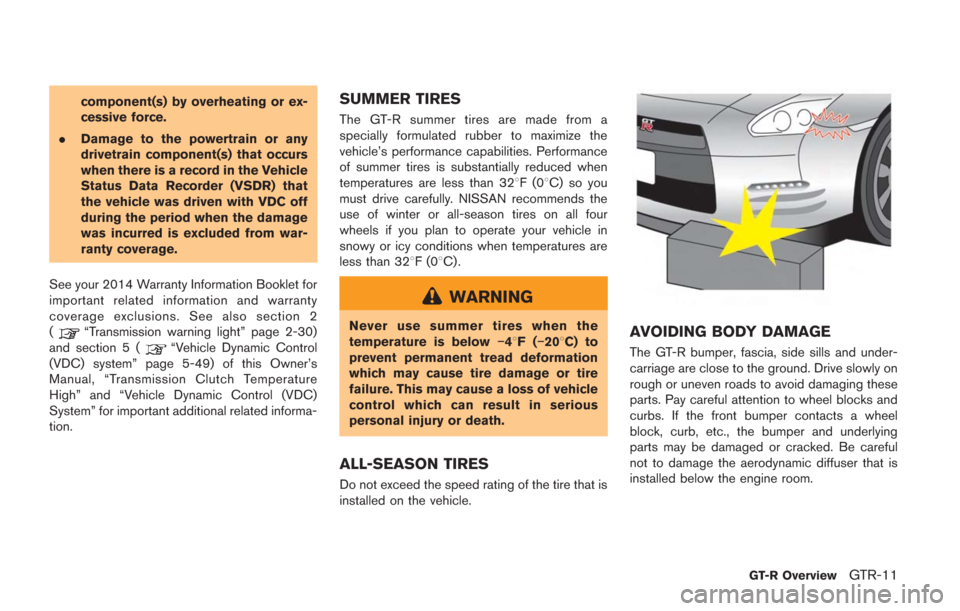
component(s) by overheating or ex-
cessive force.
. Damage to the powertrain or any
drivetrain component(s) that occurs
when there is a record in the Vehicle
Status Data Recorder (VSDR) that
the vehicle was driven with VDC off
during the period when the damage
was incurred is excluded from war-
ranty coverage.
See your 2014 Warranty Information Booklet for
important related information and warranty
coverage exclusions. See also section 2
(
“Transmission warning light” page 2-30)
and section 5 (“Vehicle Dynamic Control
(VDC) system” page 5-49) of this Owner’s
Manual, “Transmission Clutch Temperature
High” and “Vehicle Dynamic Control (VDC)
System” for important additional related informa-
tion.
SUMMER TIRES
The GT-R summer tires are made from a
specially formulated rubber to maximize the
vehicle’s performance capabilities. Performance
of summer tires is substantially reduced when
temperatures are less than 328F(0 8C) so you
must drive carefully. NISSAN recommends the
use of winter or all-season tires on all four
wheels if you plan to operate your vehicle in
snowy or icy conditions when temperatures are
less than 328F(0 8C) .
WARNING
Never use summer tires when the
temperature is below −48F(−208C) to
prevent permanent tread deformation
which may cause tire damage or tire
failure. This may cause a loss of vehicle
control which can result in serious
personal injury or death.
ALL-SEASON TIRES
Do not exceed the speed rating of the tire that is
installed on the vehicle.
AVOIDING BODY DAMAGE
The GT-R bumper, fascia, side sills and under-
carriage are close to the ground. Drive slowly on
rough or uneven roads to avoid damaging these
parts. Pay careful attention to wheel blocks and
curbs. If the front bumper contacts a wheel
block, curb, etc., the bumper and underlying
parts may be damaged or cracked. Be careful
not to damage the aerodynamic diffuser that is
installed below the engine room.
GT-R OverviewGTR-11
Page 43 of 354
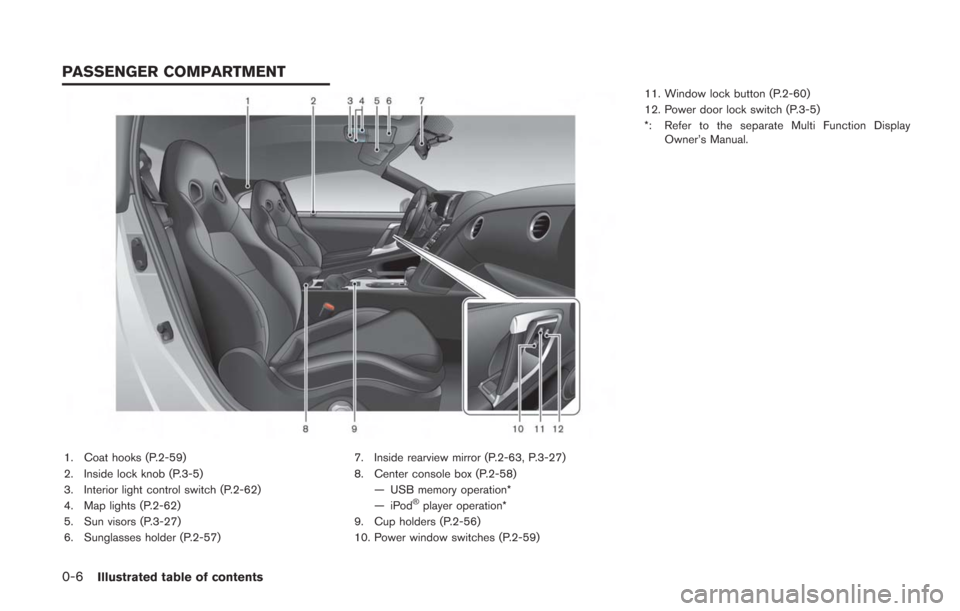
0-6Illustrated table of contents
1. Coat hooks (P.2-59)
2. Inside lock knob (P.3-5)
3. Interior light control switch (P.2-62)
4. Map lights (P.2-62)
5. Sun visors (P.3-27)
6. Sunglasses holder (P.2-57)7. Inside rearview mirror (P.2-63, P.3-27)
8. Center console box (P.2-58)
— USB memory operation*
—iPod
®player operation*
9. Cup holders (P.2-56)
10. Power window switches (P.2-59) 11. Window lock button (P.2-60)
12. Power door lock switch (P.3-5)
*: Refer to the separate Multi Function Display
Owner’s Manual.
PASSENGER COMPARTMENT
Page 48 of 354
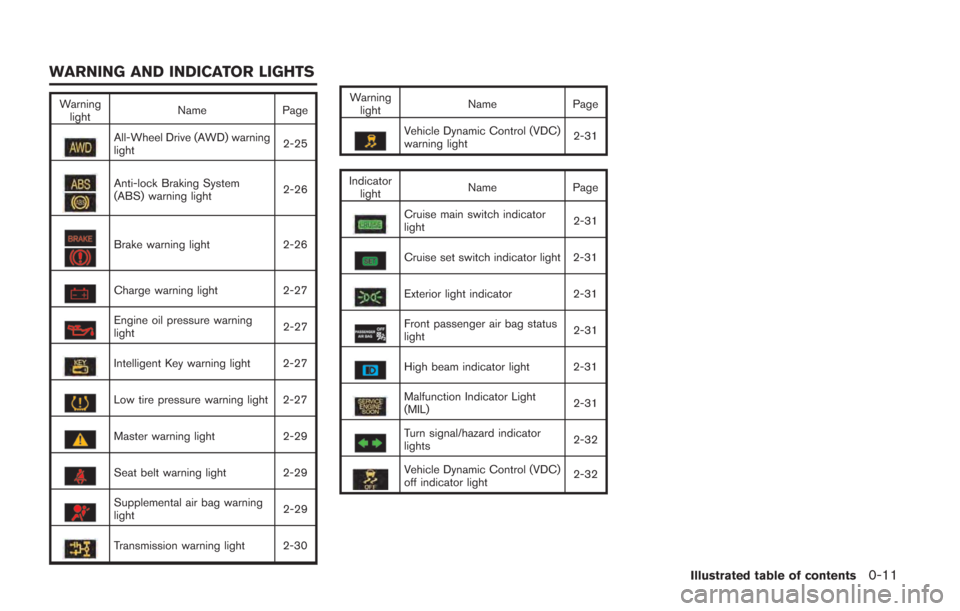
Warninglight Name
Page
All-Wheel Drive (AWD) warning
light 2-25
Anti-lock Braking System
(ABS) warning light2-26
Brake warning light
2-26
Charge warning light2-27
Engine oil pressure warning
light 2-27
Intelligent Key warning light 2-27
Low tire pressure warning light 2-27
Master warning light
2-29
Seat belt warning light 2-29
Supplemental air bag warning
light 2-29
Transmission warning light 2-30 Warning
light Name
Page
Vehicle Dynamic Control (VDC)
warning light 2-31
Indicator light Name
Page
Cruise main switch indicator
light 2-31
Cruise set switch indicator light 2-31
Exterior light indicator
2-31
Front passenger air bag status
light 2-31
High beam indicator light 2-31
Malfunction Indicator Light
(MIL)2-31
Turn signal/hazard indicator
lights
2-32
Vehicle Dynamic Control (VDC)
off indicator light2-32
Illustrated table of contents0-11
WARNING AND INDICATOR LIGHTS
Page 51 of 354
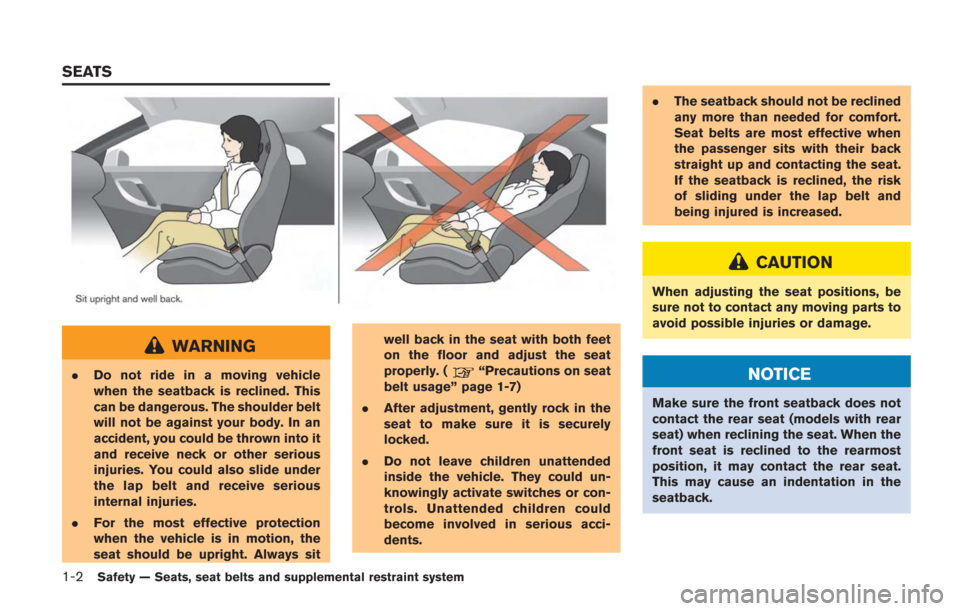
1-2Safety — Seats, seat belts and supplemental restraint system
WARNING
.Do not ride in a moving vehicle
when the seatback is reclined. This
can be dangerous. The shoulder belt
will not be against your body. In an
accident, you could be thrown into it
and receive neck or other serious
injuries. You could also slide under
the lap belt and receive serious
internal injuries.
. For the most effective protection
when the vehicle is in motion, the
seat should be upright. Always sit well back in the seat with both feet
on the floor and adjust the seat
properly. (“Precautions on seat
belt usage” page 1-7)
. After adjustment, gently rock in the
seat to make sure it is securely
locked.
. Do not leave children unattended
inside the vehicle. They could un-
knowingly activate switches or con-
trols. Unattended children could
become involved in serious acci-
dents. .
The seatback should not be reclined
any more than needed for comfort.
Seat belts are most effective when
the passenger sits with their back
straight up and contacting the seat.
If the seatback is reclined, the risk
of sliding under the lap belt and
being injured is increased.
CAUTION
When adjusting the seat positions, be
sure not to contact any moving parts to
avoid possible injuries or damage.
NOTICE
Make sure the front seatback does not
contact the rear seat (models with rear
seat) when reclining the seat. When the
front seat is reclined to the rearmost
position, it may contact the rear seat.
This may cause an indentation in the
seatback.
SEATS
Page 54 of 354
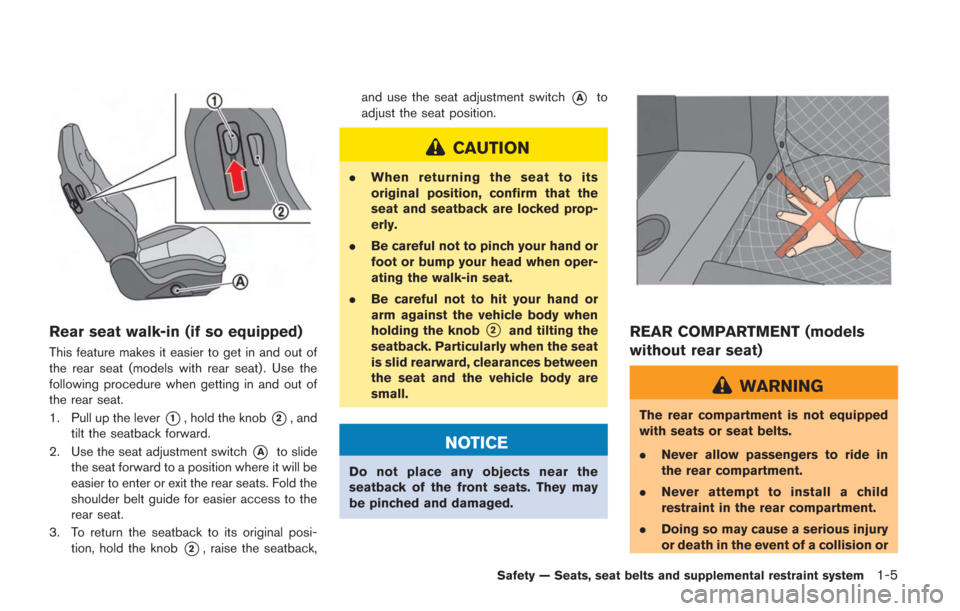
Rear seat walk-in (if so equipped)
This feature makes it easier to get in and out of
the rear seat (models with rear seat) . Use the
following procedure when getting in and out of
the rear seat.
1. Pull up the lever
*1, hold the knob*2, and
tilt the seatback forward.
2. Use the seat adjustment switch
*Ato slide
the seat forward to a position where it will be
easier to enter or exit the rear seats. Fold the
shoulder belt guide for easier access to the
rear seat.
3. To return the seatback to its original posi- tion, hold the knob
*2, raise the seatback, and use the seat adjustment switch
*Ato
adjust the seat position.
CAUTION
. When returning the seat to its
original position, confirm that the
seat and seatback are locked prop-
erly.
. Be careful not to pinch your hand or
foot or bump your head when oper-
ating the walk-in seat.
. Be careful not to hit your hand or
arm against the vehicle body when
holding the knob
*2and tilting the
seatback. Particularly when the seat
is slid rearward, clearances between
the seat and the vehicle body are
small.
NOTICE
Do not place any objects near the
seatback of the front seats. They may
be pinched and damaged.
REAR COMPARTMENT (models
without rear seat)
WARNING
The rear compartment is not equipped
with seats or seat belts.
. Never allow passengers to ride in
the rear compartment.
. Never attempt to install a child
restraint in the rear compartment.
. Doing so may cause a serious injury
or death in the event of a collision or
Safety — Seats, seat belts and supplemental restraint system1-5
Page 59 of 354
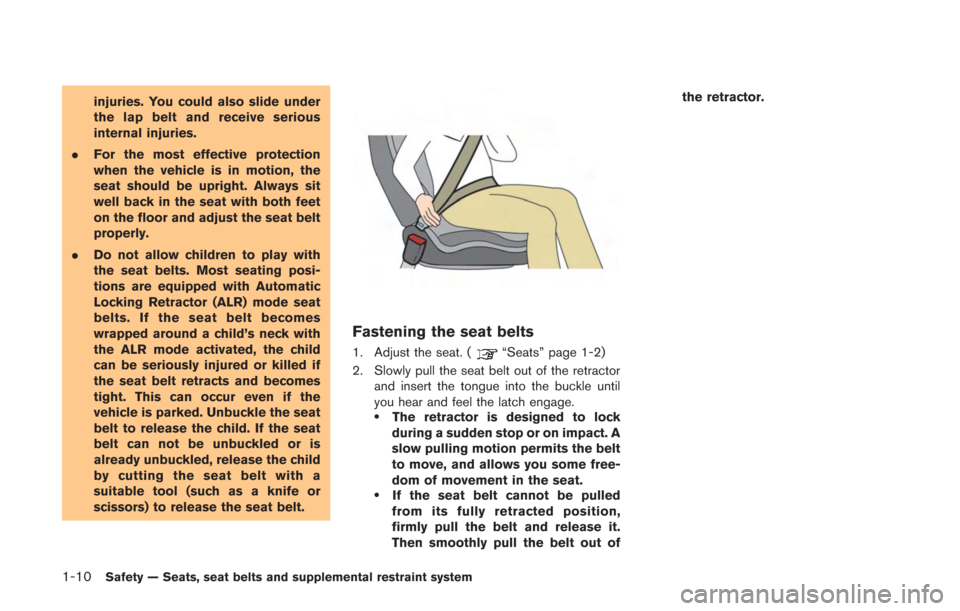
1-10Safety — Seats, seat belts and supplemental restraint system
injuries. You could also slide under
the lap belt and receive serious
internal injuries.
. For the most effective protection
when the vehicle is in motion, the
seat should be upright. Always sit
well back in the seat with both feet
on the floor and adjust the seat belt
properly.
. Do not allow children to play with
the seat belts. Most seating posi-
tions are equipped with Automatic
Locking Retractor (ALR) mode seat
belts. If the seat belt becomes
wrapped around a child’s neck with
the ALR mode activated, the child
can be seriously injured or killed if
the seat belt retracts and becomes
tight. This can occur even if the
vehicle is parked. Unbuckle the seat
belt to release the child. If the seat
belt can not be unbuckled or is
already unbuckled, release the child
by cutting the seat belt with a
suitable tool (such as a knife or
scissors) to release the seat belt.
Fastening the seat belts
1. Adjust the seat. (“Seats” page 1-2)
2. Slowly pull the seat belt out of the retractor and insert the tongue into the buckle until
you hear and feel the latch engage.
.The retractor is designed to lock
during a sudden stop or on impact. A
slow pulling motion permits the belt
to move, and allows you some free-
dom of movement in the seat.
.If the seat belt cannot be pulled
from its fully retracted position,
firmly pull the belt and release it.
Then smoothly pull the belt out of the retractor.
Page 60 of 354
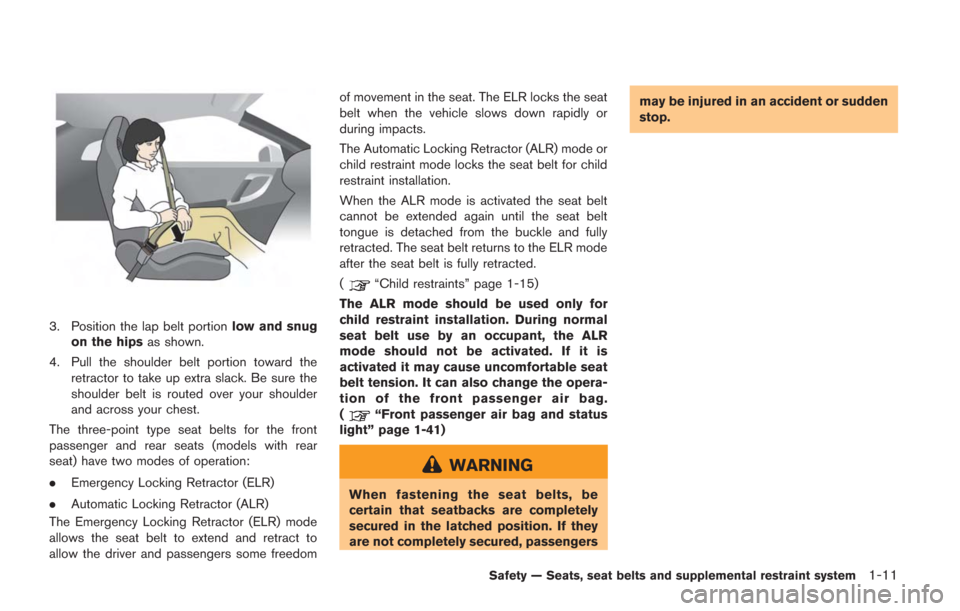
3. Position the lap belt portionlow and snug
on the hips as shown.
4. Pull the shoulder belt portion toward the retractor to take up extra slack. Be sure the
shoulder belt is routed over your shoulder
and across your chest.
The three-point type seat belts for the front
passenger and rear seats (models with rear
seat) have two modes of operation:
. Emergency Locking Retractor (ELR)
. Automatic Locking Retractor (ALR)
The Emergency Locking Retractor (ELR) mode
allows the seat belt to extend and retract to
allow the driver and passengers some freedom of movement in the seat. The ELR locks the seat
belt when the vehicle slows down rapidly or
during impacts.
The Automatic Locking Retractor (ALR) mode or
child restraint mode locks the seat belt for child
restraint installation.
When the ALR mode is activated the seat belt
cannot be extended again until the seat belt
tongue is detached from the buckle and fully
retracted. The seat belt returns to the ELR mode
after the seat belt is fully retracted.
(
“Child restraints” page 1-15)
The ALR mode should be used only for
child restraint installation. During normal
seat belt use by an occupant, the ALR
mode should not be activated. If it is
activated it may cause uncomfortable seat
belt tension. It can also change the opera-
tion of the front passenger air bag.
(
“Front passenger air bag and status
light” page 1-41)
WARNING
When fastening the seat belts, be
certain that seatbacks are completely
secured in the latched position. If they
are not completely secured, passengers may be injured in an accident or sudden
stop.
Safety — Seats, seat belts and supplemental restraint system1-11